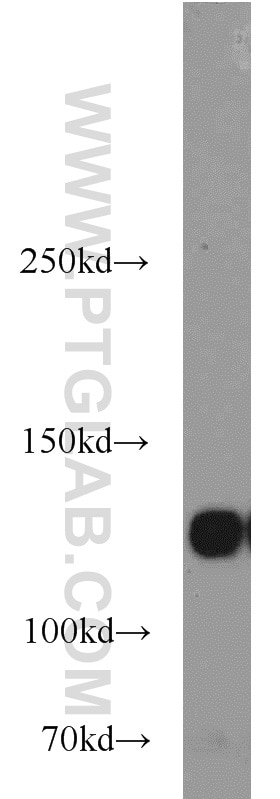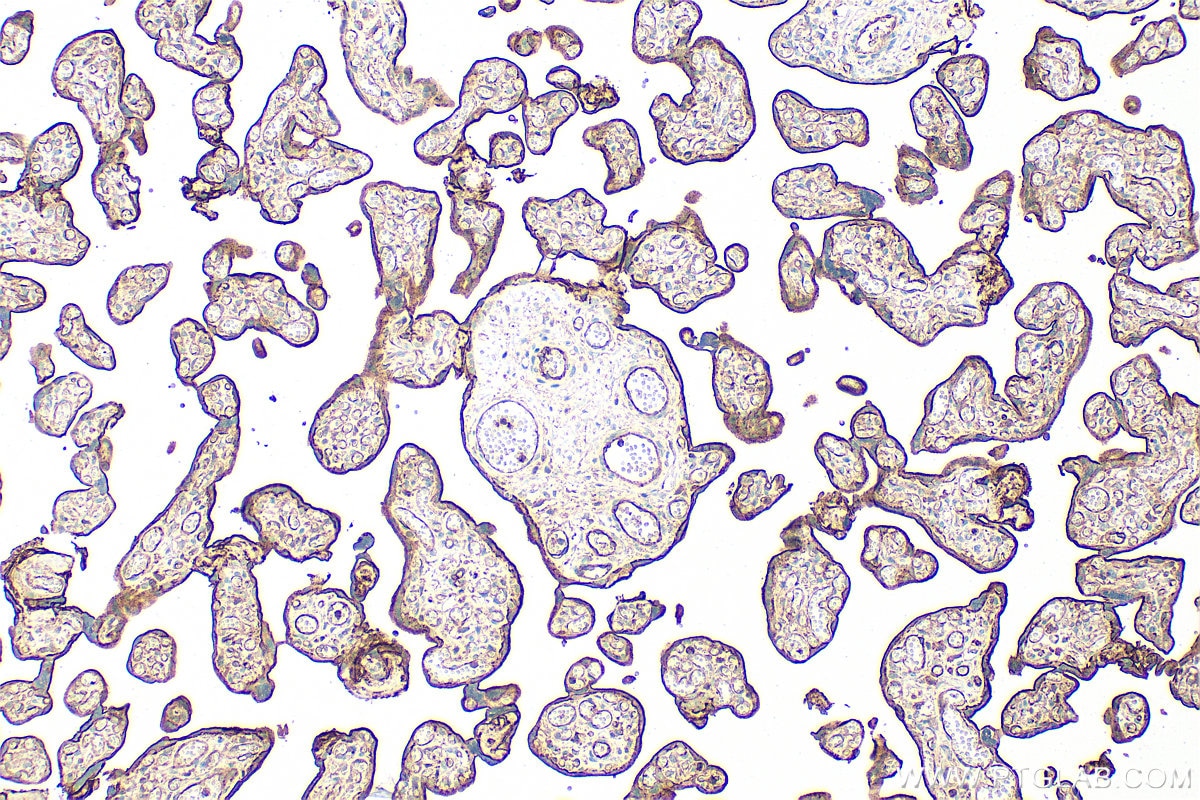Tested Applications
| Positive WB detected in | A549 cells, 3T3-L1 cells, COS-7 cells, HeLa cells, human placenta tissue, Calu-1 cells, NIH/3T3 cells |
| Positive IHC detected in | human placenta tissue, human skin cancer tissue Note: suggested antigen retrieval with TE buffer pH 9.0; (*) Alternatively, antigen retrieval may be performed with citrate buffer pH 6.0 |
Recommended dilution
| Application | Dilution |
|---|---|
| Western Blot (WB) | WB : 1:1000-1:8000 |
| Immunohistochemistry (IHC) | IHC : 1:300-1:1200 |
| It is recommended that this reagent should be titrated in each testing system to obtain optimal results. | |
| Sample-dependent, Check data in validation data gallery. | |
Published Applications
| KD/KO | See 3 publications below |
| WB | See 31 publications below |
| IHC | See 2 publications below |
| IF | See 10 publications below |
Product Information
10569-1-AP targets Integrin alpha-5/CD49e in WB, IHC, IF, ELISA applications and shows reactivity with human, mouse, monkey samples.
| Tested Reactivity | human, mouse, monkey |
| Cited Reactivity | human, mouse, rat |
| Host / Isotype | Rabbit / IgG |
| Class | Polyclonal |
| Type | Antibody |
| Immunogen |
CatNo: Ag0860 Product name: Recombinant human Integrin alpha-5 protein Source: e coli.-derived, PGEX-4T Tag: GST Domain: 749-1049 aa of BC008786 Sequence: FTVPHLRDTKKTIQFDFQILSKNLNNSQSDVVSFRLSVEAQAQVTLNGVSKPEAVLFPVSDWHPRDQPQKEEDLGPAVHHVYELINQGPSSISQGVLELSCPQALEGQQLLYVTRVTGLNCTTNHPINPKGLELDPEGSLHHQQKREAPSRSSASSGPQILKCPEAECFRLRCELGPLHQQESQSLQLHFRVWAKTFLQREHQPFSLQCEAVYKALKMPYRILPRQLPQKERQVATAVQWTKAEGSYGVPLWIIILAILFGLLLLGLLIYILYKLGFFKRSLPYGTAMEKAQLKPPATSDA Predict reactive species |
| Full Name | integrin, alpha 5 (fibronectin receptor, alpha polypeptide) |
| Calculated Molecular Weight | 115 kDa |
| Observed Molecular Weight | 135-150 kDa |
| GenBank Accession Number | BC008786 |
| Gene Symbol | Integrin alpha 5 |
| Gene ID (NCBI) | 3678 |
| RRID | AB_2130060 |
| Conjugate | Unconjugated |
| Form | Liquid |
| Purification Method | Antigen affinity purification |
| UNIPROT ID | P08648 |
| Storage Buffer | PBS with 0.02% sodium azide and 50% glycerol, pH 7.3. |
| Storage Conditions | Store at -20°C. Stable for one year after shipment. Aliquoting is unnecessary for -20oC storage. 20ul sizes contain 0.1% BSA. |
Background Information
Integrins are cell adhesion receptors that are heterodimers composed of non-covalently associated alpha and beta subunits. Integrin alpha 5 (ITGA5), belongs to the integrin alpha chain family, primarily binds to Integrin beta 1 (ITGB1) to form an α5β1 heterodimer (PMID: 33711961). Integrin α5β1 is a specific receptor of fibronectin through its arginine-glycine-aspartic acid (RGD) binding site (PMID: 19608542). Integrin α5β1 plays roles in cell adhesion, migration and matrix formation, and has emerged as an essential mediator in many human carcinomas (PMID: 33408483).
Protocols
| Product Specific Protocols | |
|---|---|
| IHC protocol for Integrin alpha-5/CD49e antibody 10569-1-AP | Download protocol |
| WB protocol for Integrin alpha-5/CD49e antibody 10569-1-AP | Download protocol |
| Standard Protocols | |
|---|---|
| Click here to view our Standard Protocols |
Publications
| Species | Application | Title |
|---|---|---|
Biomaterials Osteogenesis potential of different titania nanotubes in oxidative stress microenvironment. | ||
Int J Mol Sci Atp6v1h Deficiency Blocks Bone Loss in Simulated Microgravity Mice through the Fos-Jun-Src-Integrin Pathway | ||
Front Cell Dev Biol Mesenchymal Stem Cells With Cancer-Associated Fibroblast-Like Phenotype Stimulate SDF-1/CXCR4 Axis to Enhance the Growth and Invasion of B-Cell Acute Lymphoblastic Leukemia Cells Through Cell-to-Cell Communication. | ||
Oncotarget Annexin A4 fucosylation enhances its interaction with the NF-kB p50 and promotes tumor progression of ovarian clear cell carcinoma. | ||
Front Oncol ITGA5 Is a Novel Oncogenic Biomarker and Correlates With Tumor Immune Microenvironment in Gliomas. | ||
Front Oncol ITGA5 Predicts Dual-Drug Resistance to Temozolomide and Bevacizumab in Glioma. |
Reviews
The reviews below have been submitted by verified Proteintech customers who received an incentive for providing their feedback.
FH Boyan (Verified Customer) (02-04-2019) | Excellent. In WB, it gives a protein band at the expected molecular weight, and this band was decreased during adipocyte differentiation, which is consistent with those reported in literature. In IF, it labels endogenous protein at the cell surface, as that reported in literature.
|






















